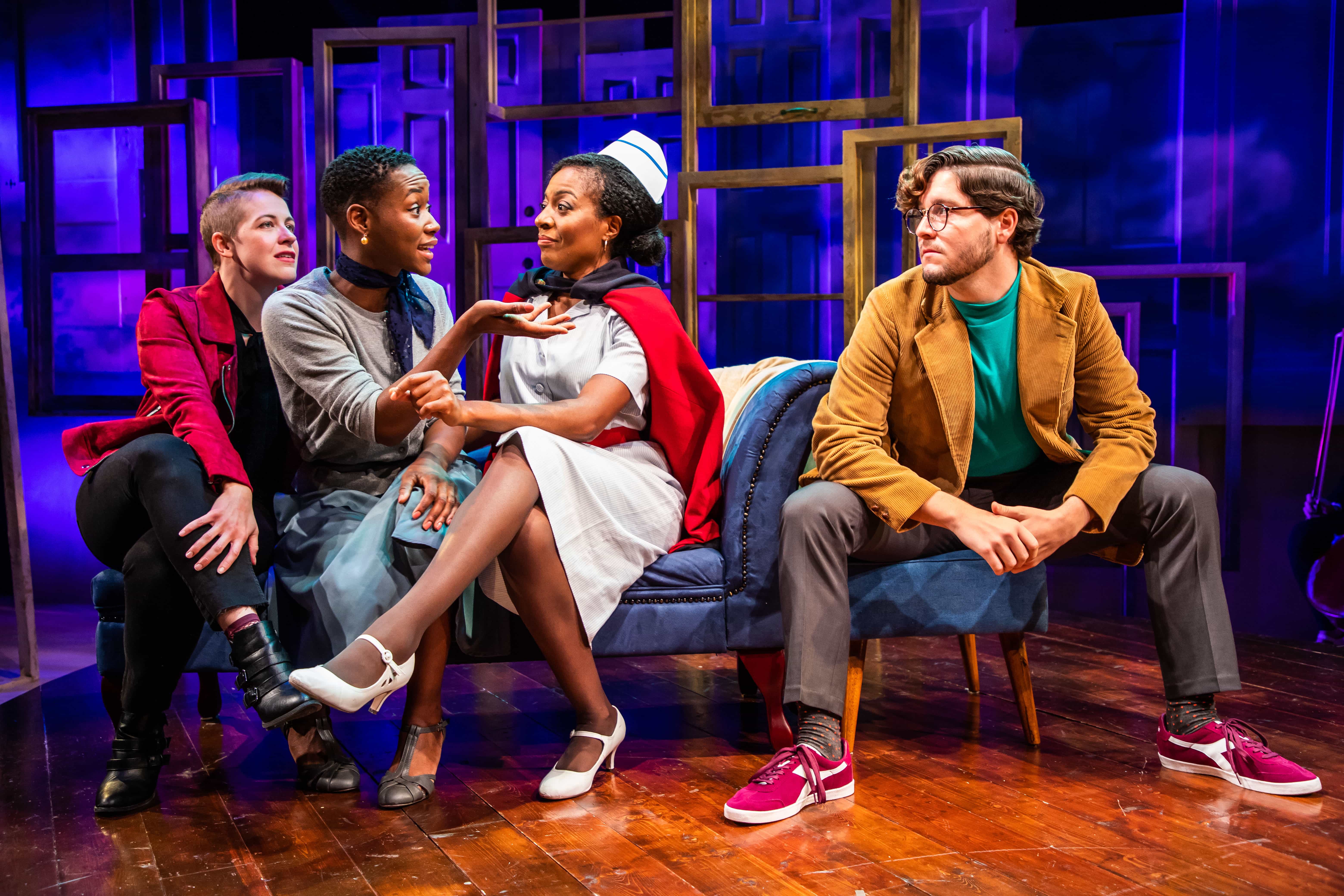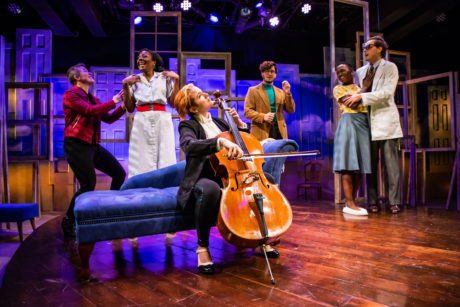In Jonathan Dahm Robertson’s set for Constellation Theatre Company’s production of Sarah Ruhl’s Melancholy Play: A Contemporary Farce, a collection of two-dimensional doors is depicted on the face of the backdrop. So it is clear from the outset that this is not going to be the sort of farce (e.g., Noises Off), in which rapid-fire entrances and exits from a variety of doors will be the principal comic element.

Rather, the farcical nature of the play rests on the content of Ruhl’s script as executed by the disciplined, consistent, intentional artifice of the cast’s performances, well coordinated by director Nick Martin. There is no attempt at naturalism here. The actors frequently take.a.little.beat.between.each.word.in.a.line. In a web page concerning the play, Ruhl counsels actors not to be afraid of “sincere melodrama,” and the gestural style of the production is frequently reminiscent of what one might see in a production of a 19th-century melodrama.
The cast is uniformly excellent. This is the third time this summer I have seen the lead, Billie Krishawn, all in quite different roles, and her range, as well as her dynamism, are evident here. As Tilly, she is initially melancholic: not clinically depressed or introverted, but gently sad, wistful, full of longing, even erotic, which, rather than annoying everyone, causes other characters quickly to fall in love with her. What really disorients the other characters is when, after an abrupt transition near the end of the first portion of the show (it has something to do with a game of duck, duck, goose), she becomes unremittingly, unmercifully, bubbling-over cheerful.
The people in Tilly’s orbit begin with her therapist, Lorenzo (Christian Montgomery), bringing with him an exaggerated, vaguely Italianate accent (which he drops for one line to hilarious effect) and an equally unbelievable origin story. Then there’s the tailor Frank (John Austin), a rather earnest young man with Clark Kent glasses, who (of course) falls in love with her, which she returns as long as she remains melancholy. Frank has a couple of almost-unison monologues (the reason for the unison is revealed late in the show, in a plot development fitting in such a comedy of errors), with physicist-turned-hairdresser Frances (Mary Myers) – who herself becomes besotted with Tilly in the course of a haircut. What to do? Of course, take her home to tea with Frances’ partner Joan, a rather prim nurse (Lilian Oben). Joan too swoons.
The second part of the show becomes absurdist in tone, centering on the transformation of one character — deeply depressed and increasingly insular in reaction to Tilly’s conversion to happiness — into an almond. Not a metaphorical almond, mind, but an actual small brown nut, carefully displayed on a delicate white pillow. (One review I saw of a college production quite seriously urged people with tree nut allergies not to attend the show). The scene promises to be a staple of acting classes, as students work at relating a scene partner who does not provide the usual facial and verbal reactions. The cast manages the human-nut interaction quite creditably.
There is a backstory to the almond theme. Ruhl has referred to the amygdala, a portion of the brain involved with emotional response, which is named after a Greek word for “almond.” Robertson’s set picks up the theme nicely, with the main playing area platform being a brown oval suggestive of the nut. The set also features an attractive and useful array of movable window frames, through which actors at times peer and enter.
The almond references are not the only nutty moments in the show, of course. There are the references to “sweaty cows.” Three characters obsess briefly over small triangular sandwiches. The height of the evening’s physical humor is a slow-motion struggle between Frank and Lorenzo over a vial of Tilly’s tears, after which the profession of fight choreography may never be quite the same.
Kitt Crescenzo’s costume designs suit the characters admirably. The melancholic Tilly’s outfit is subdued light gray and blue. When she turns happy, she sheds her gray sweater revealing a bright, multicolored blouse. The sweater lands on Lorenzo, who has himself become melancholy after Tilly’s transformation. Previously, he had worn brighter colors – a green shirt and maroon sneakers, for example. Frank is all businesslike propriety, white coat over a white shirt and tie. Frances is in all black while Joan is in a white nurse’s outfit and hat, even at home. A.J. Guban’s lighting design is likewise strong on color, with hues changing with the moods of characters and scenes, as well as providing a tighter focus on moments highlighting an individual, for example when an actor is looking through a window frame.

Though the cast has a couple brief songs, the show is not a musical. (There is a subsequent chamber musical version, with music written by a composer named, as luck would have it, Todd Almond). There is, however, excellent musical accompaniment/commentary provided by solo cellist Kate Rears Burgman, playing an original score by Wytold.
Ruhl has a somewhat serious point behind the highly stylized comedy. Melancholy is a set of real feelings to be appreciated and respected, not simply sentimentalized away as in the lyrics to the American Songbook standard, “Melancholy Baby.” “Smile my honey dear, while I kiss away each tear” is distinctly not the theme of this play. For these five characters in search of an almond, the balance they ultimately find between the poles of their emotional lives is the point of the exercise.
Running Time: One hour and 35 minutes, with no intermission.
Melancholy Play: A Contemporary Farce is playing at the Constellation Theatre Company in the Source Theater space at 1835 14th Street, NW, Washington DC. The show runs through September 2 (except August 14-22). For tickets, call 202-204-7741 or go online.





I respectfully disagree, although most of the account Mr. Ashby gives is factually correct.
What he fails to mention, however, is how tedious, disengaging, and unconvincing this story is. There is nothing to make us care about any of the characters, whether they be almonds or human beings.
The most remarkable characteristic of Tilly is that she is *not* melancholy. Interviewed by her psychiatrist, she appears a little languid and self-important, but that is hardly a clinical state — and certainly doesn’t justify the medication he is prescribing.
That her psychiatrist then declares his love for her is major-league creepy. Moreover, it is entirely unmotivated. As Tilly prattles on and on about her disappointments in the quotidian events of her life, it is soporific, not erotic. The fact that her psychiatrist — who is at bottom an implausible character — then falls in love with her shows a disrespect on playwright’s Ruhl’s part for the basic elements of credibility.
I recognize that the over-the-top performances represented a sincere effort by director Martin to achieve Ruhl’s intention. That didn’t make it any less grating on the audience.
Is it Ruhl’s point, as Mr Ashby suggests, that melancholy is a set of real feelings to be appreciated and respected? Of course, we should appreciate and respect all feelings. But if that is Ruhl’s point it is sabotaged by (1) the fact that Tilly is not melancholy, but merely makes gestures toward melancholy (2) the other characters don’t simply *respect* her melancholy, but eroticize it, (3) when Tilly loses her melancholy, she becomes not a normal person but hypermanic, which explains why people are no longer attracted to her, and (4) people turn into almonds.
This is a dreadful story, and Constellation’s effort to give it a true and intentional production, unfortunately, doesn’t make it any better.